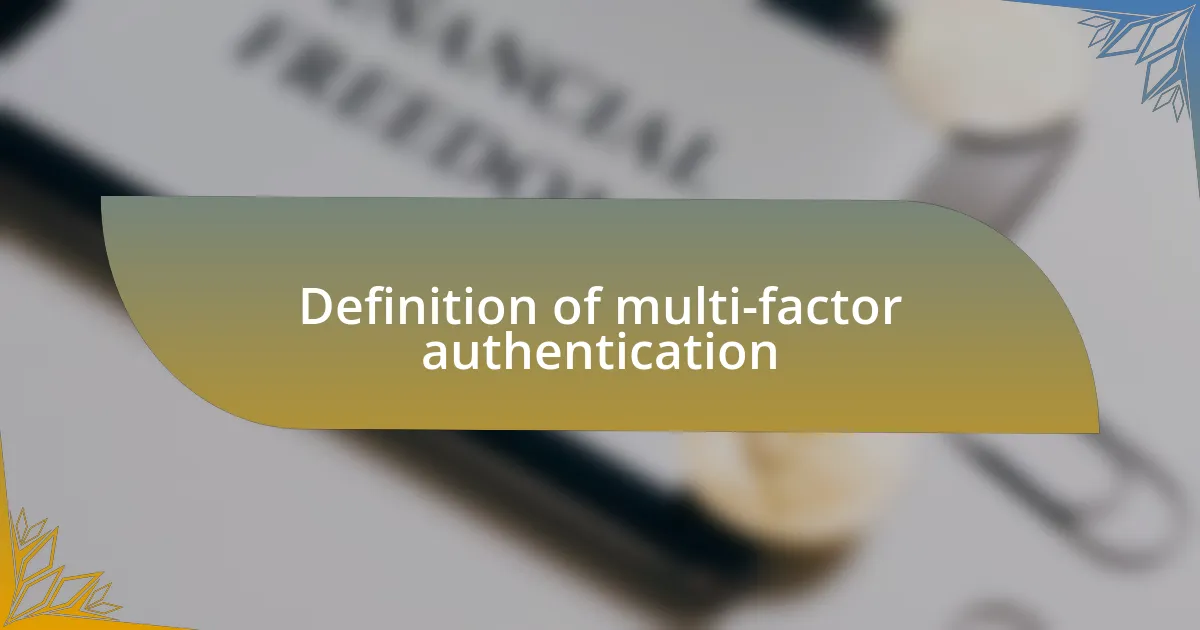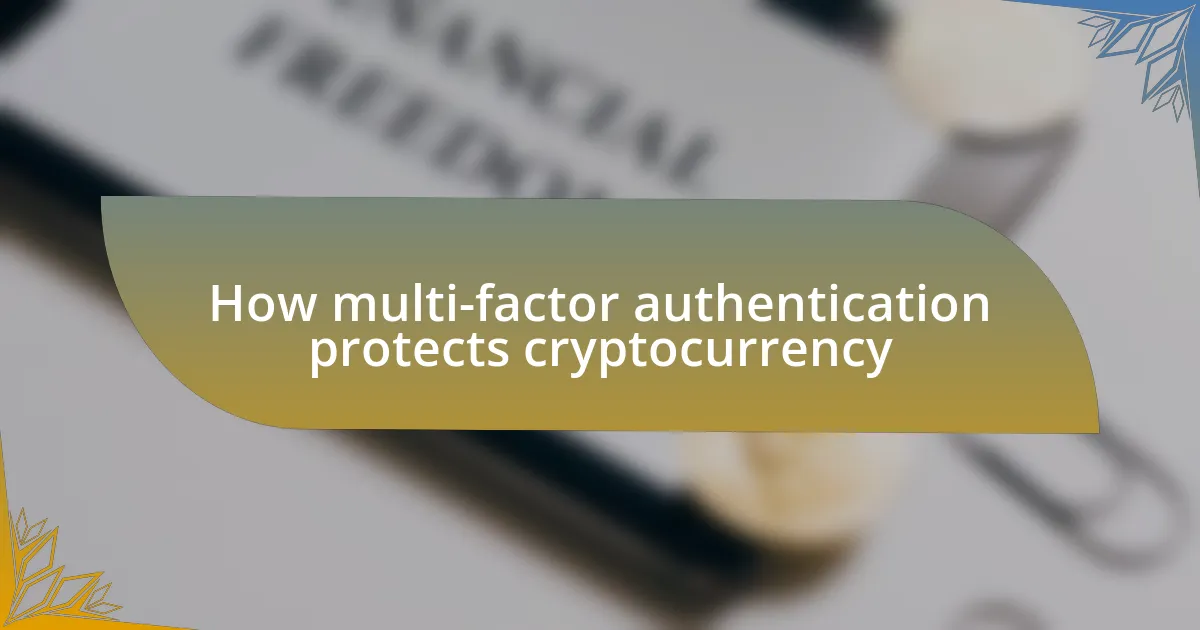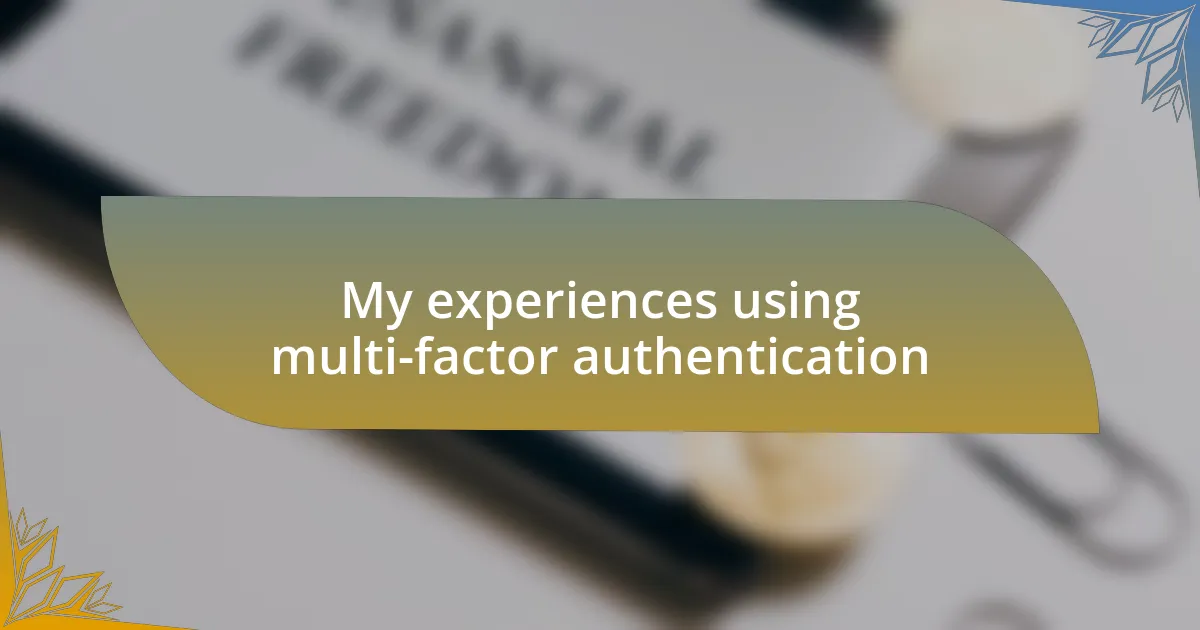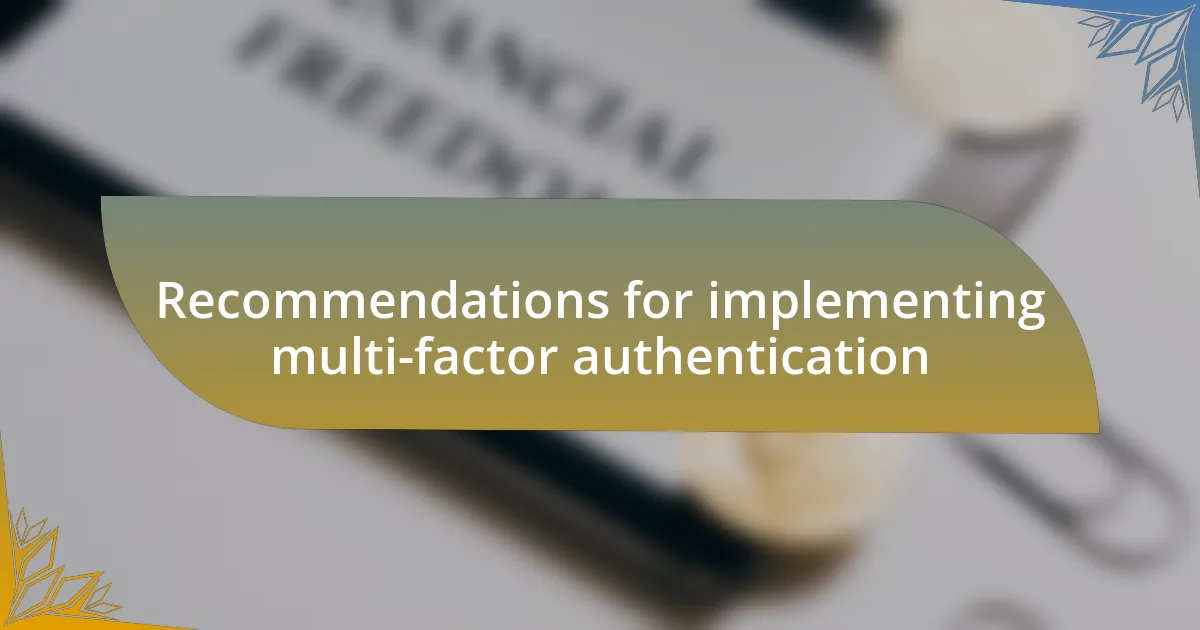Key takeaways:
- Multi-factor authentication (MFA) enhances online security by requiring two or more verification factors, significantly reducing the risk of account breaches.
- Common MFA methods include one-time passwords (OTP), app-based authentication, and biometric verification, each offering varying levels of convenience and security.
- Personal experiences underscore the effectiveness of MFA in preventing unauthorized access and raising awareness about online security risks.
- Choosing reliable MFA methods, regularly updating settings, and educating others are essential practices for maximizing the benefits of multi-factor authentication.

Definition of multi-factor authentication
Multi-factor authentication (MFA) is a security measure that requires users to provide two or more verification factors to gain access to their accounts. This approach goes beyond just a simple password, incorporating something you know (like a PIN), something you have (like a smartphone app), or something you are (like a fingerprint). I recall a time when I lost access to one of my accounts because I relied solely on my password. It made me realize how essential it is to have that extra layer of protection.
Imagine this: you’re about to make a significant investment in cryptocurrency, and suddenly, you face an account breach. With MFA, that scenario becomes far less likely. By verifying your identity through multiple channels, you add an extra hurdle for potential attackers. It’s reassuring to know that even if someone steals your password, they won’t have the second factor needed to access your account.
In essence, MFA serves as a robust fortress for your digital assets. As I’ve adopted this security practice in my own online dealings, it’s transformed my approach to managing sensitive information. Have you ever considered how much safer you’d feel knowing that you’re not just relying on a single password? This layered security not only protects you but also fosters confidence in the overall integrity of your cryptocurrency investments.

How multi-factor authentication protects cryptocurrency
Layering security is vital when it comes to managing cryptocurrency, and that’s precisely what multi-factor authentication (MFA) achieves. The thought of losing my hard-earned digital assets because of a hacker sends chills down my spine. I remember a friend who didn’t use MFA and suffered a significant loss. If they had that extra layer, they might have avoided that disaster. It’s a reminder that in today’s digital landscape, we can’t afford to be complacent.
Using MFA means that even if a hacker gets hold of your password, they won’t have the additional verification required to access your account. I often think about this when I log in to my own accounts. Knowing that I have to input a code sent to my phone, for example, gives me peace of mind. It’s like having a two-step lock on my front door; a determined burglar might get through the first lock, but they would struggle with the second.
Moreover, MFA enhances my overall security posture. I’ve become more cautious about where I enter my credentials, understanding that a robust authentication method diminishes risks significantly. Ask yourself, would you rather have a single key to your vault or reinforce it with multiple locks? Embracing MFA feels like adding numerous safeguards to protect my investments, ensuring I can focus on growing rather than worrying about potential security breaches.

Types of multi-factor authentication methods
When it comes to multi-factor authentication methods, there are several effective approaches. One common method is using a one-time password (OTP) sent via SMS. I remember the first time I received an OTP; it felt like the app was looking out for me, adding that extra layer of security. But, it’s crucial to consider the risks associated with SMS – if someone intercepts those messages, they could compromise your account.
Another popular method involves app-based authentication, like Google Authenticator or Authy. These apps generate time-sensitive codes that I find especially reassuring because they combine convenience with security. I often use these apps for my cryptocurrency accounts; knowing the code changes every 30 seconds makes me feel that much safer. Have you ever felt the tension of relying solely on a password? With app-based authentication, I feel empowered, like I have control over my own digital safety.
Biometric authentication, such as fingerprint scanning or facial recognition, is becoming increasingly common as well. I’ll admit, the first time I unlocked my phone with my face, I felt a surge of technological advancement at my fingertips. It’s fascinating to think that such a personal touch can add to security measures, but it also raises questions about privacy. To what extent are we willing to share our biological data to guard our digital assets? This balancing act between convenience and safety is something I contemplate as we advance in such a rapidly evolving digital world.

My experiences using multi-factor authentication
Using multi-factor authentication has genuinely changed how I approach online security. Initially, I felt a bit overwhelmed when I set it up for my cryptocurrency accounts; there were so many options to choose from! However, after experiencing how effectively it protects my assets, I quickly realized this extra step is worth every moment spent on setup.
I vividly remember one evening when I tried to log into my crypto wallet and received a notification that my OTP was sent. My heart raced a little – it was a reminder that someone could have easily accessed my account if not for that simple, yet powerful, safeguard. That moment reinforced my belief in multi-factor authentication; it provides a sense of security I hadn’t experienced before.
Not too long ago, I had a close call with phishing, where I almost clicked on a fraudulent link that appeared genuine. Thankfully, because I had multi-factor authentication enabled, I received an alert warning me about the login attempt. It made me reflect on how vulnerable we often are without these added layers of security. Have you ever had that sense of relief knowing that even a mistake won’t lead to disaster? For me, it’s a wake-up call about how protecting our digital identities is as essential as guarding our physical ones.

Recommendations for implementing multi-factor authentication
When implementing multi-factor authentication, it’s crucial to choose a combination of methods that resonate with your lifestyle. Personally, I prefer using a mobile authenticator app rather than SMS. I find that the reliability and speed of apps like Google Authenticator enhance my overall experience. Why? Because it eliminates the risk of SIM swapping attacks, which I learned about after reading a few harrowing stories online.
It’s also important to regularly review and update your MFA settings. I remember an instance when I switched phones and forgot to transfer my authenticator app. I faced a mild panic when trying to log into my accounts. This situation taught me to back up my recovery codes and remind myself to reconfigure my MFA settings whenever I upgrade my devices. Have you considered what might happen during a tech upgrade?
Lastly, educating users about the significance of multi-factor authentication can’t be overstated. I often have conversations with friends who dismiss it as an inconvenience, but I always emphasize how much more secure their accounts will be. In my own experience, explaining the process and benefits helps them feel empowered rather than overwhelmed, turning what often seems like a hassle into a necessary step for safety.